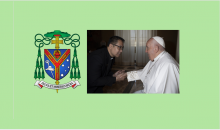(1 gennaio, ora australiana - AEST). Oggi, il vescovo eletto mons. Rene Ramirez RCJ della arcidiocesi di Melbourne ha pubblicato su YouTube il suo stemma e il significato dei simboli in esso contenuti. (link: https://www.youtube.com/watch?v=Z7s0djhG4yk)
Lo scudo è blu con una banda rossa bordata d'oro che sostiene tre spighe di grano dorate, una per lato. Nella parte superiore dello scudo c'è il Sacro Cuore di Gesù, raffigurato in una bellezza radiosa. Sul lato destro, c'è un bastone d'argento posto in diagonale con sopra un cappello da pastorella. Sul lato sinistro ci sono cinque stelle, tutte in argento: una a otto punte, due a sette punte, una a sei punte e una a cinque punte. Queste stelle simboleggiano la costellazione della Croce del Sud.
Dietro lo scudo c'è una croce vescovile e il tutto è sormontato da un galero romano di colore verde con sei nappe pendenti su ogni lato, disposte in uno schema di 1, 2 e 3.
Il motto è “Zelus et misericordia”, che significa “zelo e compassione”.
Cosa significano questi simboli?
Il campo dello stemma è diviso in tre scomparti da un pallio, che è un ordinario araldico a forma di Y.
Il Sacro Cuore raggiante e le spighe di grano poste sul pallio sono presenti anche nel logo della Congregazione dei Rogazionisti del Cuore di Gesù, di cui il vescovo è membro professo. La devozione al Sacro Cuore di Gesù è stata promossa da Sant'Annibale Maria Di Francia, fondatore della Congregazione e figura ispiratrice del Vescovo.
Il bastone e il cappello della pastorella rappresentano la Beata Vergine Maria nel suo titolo “La Divina Pastora”, che è la patrona del luogo di nascita del Vescovo a Gapan City, nelle Filippine. Il Vescovo ha vissuto sotto la protezione della Madonna e ritiene che sia stato proprio nel suo luogo di nascita che sono stati gettati i primi semi della sua vocazione.
Sul retro dello scudo ci sono cinque stelle disposte a formare la costellazione della Croce del Sud. Questo emblema non solo rappresenta l'Australia, ma rende anche omaggio alle due parrocchie australiane di Braybrook e Maidstone, per le quali il Vescovo ha lavorato per fonderle nella Parrocchia della Sacra Famiglia e per rinnovarle e farle crescere come una comunità di fedeli più missionaria.
I colori utilizzati sono argento, oro, blu e rosso. Questi sono i colori delle bandiere delle Filippine e dell'Australia, entrambe significative per la vita del Vescovo.
La croce episcopale ha la forma della croce di Paderborn, ispirata allo stemma della diocesi di Sandhurst, dove il vescovo ha servito come pastore per un anno prima della sua nomina episcopale. La Croce di Paderborn, il più antico simbolo cristiano di Paderborn, in Germania, è stata scoperta in una tomba risalente a oltre 1200 anni fa. È inclusa nello stemma della diocesi di Sandhurst in onore del Dr. Henry Backhaus, il pastore pioniere dei campi d'oro di Bendigo, originario di quella città tedesca. Sandhurst è l'antico nome dei Bendigo Goldfields. Il paesaggio e la cordialità della gente di Bendigo catturarono il cuore del Vescovo che qui ebbe la sua esperienza di “Damasco”, ovvero la sua consacrazione episcopale. Raffigurando la Croce di Paderborn, desidera onorare questa diocesi.
Il galero verde, con sei fiocchi appesi ai lati, insieme alla croce episcopale, indica che il portatore dello stemma è un vescovo.
Il motto “ZELUS ET MISERICORDIA” cattura l'essenza della missione di Gesù e la sua chiamata al servizio compassionevole, facendo eco ai suoi sentimenti in Matteo 9:35-38 durante l'incontro con la folla: Egli fu mosso da compassione perché erano “indifesi, come pecore senza pastore”.
C'è un legame profondo tra zelo e compassione: il vero zelo per l'opera del Signore nasce da un cuore che si immedesima nella sofferenza degli altri e spinge all'azione. Quando il Vescovo Rene inizia il suo ministero a Melbourne, il suo motto serve a ricordare in modo dinamico la chiamata al servizio, sollecitando non solo sentimenti di compassione ma anche una risposta attiva a chi ha bisogno.
The Coat of Arms of Most Rev. Rene Ramirez RCJ, Auxiliary Bishop-Elect of the Archdiocese of Melbourne, Australia
(January 1, Australian Eastern Standard Time). Today, Bishop-elect Mons. Rene Ramirez RCJ posted on YouTube his coat of arms and the meaning of the symbols in it. (link: https://www.youtube.com/watch?v=Z7s0djhG4yk)
The shield is blue with a red band edged in gold holding three golden wheat stalks, one on each side. At the top of the shield is the Sacred Heart of Jesus, depicted in radiant beauty. On the right (or dexter) side, there is a silver staff placed diagonally with a shepherdess's hat on it. On the left (or sinister) side are five stars, all in silver: one with eight points, two with seven points, one with six points, and one with five points. These stars symbolize the constellation of the Southern Cross.
Behind the shield is a bishop's cross, and all is surmounted by a green Roman galero with six tassels hanging down on each side, arranged in a pattern of 1, 2, and 3.
The motto is "Zelus et misericordia," which means "zeal and compassion".
What do these symbols mean?
The field of the coat of arms is divided into three compartments by a pall, which is a Y-shaped heraldic ordinary.
The radiant Sacred Heart and the ears of wheat placed on the pall are also found in the logo of the Congregation of the Rogationists of the Heart of Jesus, of which the bishop is a professed member. Devotion to the Sacred Heart of Jesus was promoted by St. Hannibal Mary Di Francia, the Founder of the Congregation and an inspirational figure for the Bishop.
The shepherdess' staff and hat represent the Blessed Virgin Mary in her title "La Divina Pastora", who is the patroness of the Bishop's birthplace in Gapan City, Philippines. The Bishop has lived under the protection of Our Lady and believes that it was in his birthplace that the first seeds of his vocation were sown.
On the back of the shield are five stars arranged to form the constellation of the Southern Cross. This emblem not only represents Australia, but also pays tribute to the two Australian parishes of Braybrook and Maidstone, where the Bishop has worked to merge them into Holy Family Parish and to renew and grow them as a more missionary community of the faithful.
The colors used are silver, gold, blue and red. These are the colors of the flags of the Philippines and Australia, both of which are significant in the Bishop's life.
The episcopal cross is in the shape of the Paderborn cross, inspired by the crest of the Diocese of Sandhurst, where the bishop served as pastor for a year before his episcopal appointment. The Paderborn Cross, the oldest Christian symbol from Paderborn, Germany, was discovered in a grave over 1200 years old. It is included in the coat of arms of the Diocese of Sandhurst in honor of Dr. Henry Backhaus, the pioneer pastor of the Bendigo Goldfields, who was from that German town. Sandhurst is the former name of the Bendigo Goldfields. The scenery and warm people of Bendigo captured the Bishop's heart, and it was here that he had his "Damascus" experience - his episcopal consecration. By depicting the Paderborn Cross, he wishes to honor this diocese.
The green galero, with six tassels hanging on either side, together with the episcopal cross, indicates that the bearer of the coat of arms is a bishop.
The motto "ZELUS ET MISERICORDIA" captures the essence of Jesus' mission and his call to compassionate service, echoing the sentiments of Matthew 9:35-38 during his encounter with the crowd: He was moved with compassion because they were "helpless, like sheep without a shepherd".
There is a deep connection between zeal and compassion: true zeal for the Lord's work comes from a heart that empathizes with the suffering of others and compels action. As Bishop Rene begins his ministry in Melbourne, his motto serves as a dynamic reminder of the call to service, urging not only feelings of compassion but also an active response to those in need.












